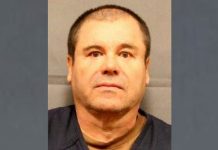
Nov. 16 (UPI) — A former member of the Mexican drug cartel allegedly led by Joaquin “El Chapo” Guzman revealed details of the kingpin’s first escape from prison during testimony Thursday.
Jesus “Rey” Zambada Garcia — a top operative in the Sinaloa Cartel — was the first of 16 informants expected to testify as Guzman stands trial for a 17-count indictment for drug trafficking, murder conspiracy and money laundering over his 25 years as the alleged leader of the cartel.
Garcia and his brother, cartel co-leader Ismail “Mayo” Zambada Garcia, organized Guzman’s escape from Puente Grande prison in 2001, including sending a helicopter to pick up the cartel boss and bringing him to a “semi-deserted location.”
“Seven a.m., the helicopter appeared and Chapo was in it,” Garcia said. “El Chapo got out. My brother was very happy and so was Chapo. He introduced me to him. That was the first time we met in person.”
Garcia recalled he told Guzman to cover his face with a newspaper as they drove 2 hours and 45 minutes to a safehouse.
He added that police soon approached the vehicle to escort them the rest of the way.
“He had the natural reaction,” Garcia said of Guzman. “He got worried but I said, ‘Don’t worry about it. These are our people. They are here to protect us. No one is going to touch us from here on out.'”
Garcia said he paid $300,000 monthly to government officials in Mexico City — federal police, judicial police, municipal police as well as airport officials, the attorney general’s office, or PGR, and Interpol — to gain protection for their drug operations.
“He would say, ‘Give half a million dollars to the attorney who was going to give it to the director of the PGR,” Garcia said of his brother. “Give another $500,000 to a general. They did it using lawyers, but I was the one who gave out the money in Mexico City.”
Garcia also detailed the cartel’s methods for transporting drugs, such as using gas tankers with hidden compartments, cross-border tunnels and switching from large trucks to small shipments of 20 kilos to 50 kilos hidden in passenger cars after drawing attention from U.S. border officials.
“It’s much harder for the authorities to detect them because on the same day thousands of vehicles are crossing,” he said. “With 10 cars with 20 kilos each, if you lose one, you’ve lost 20. That’s not a lot … It’s the ‘ant-speed’ operation to cross the drugs.”





